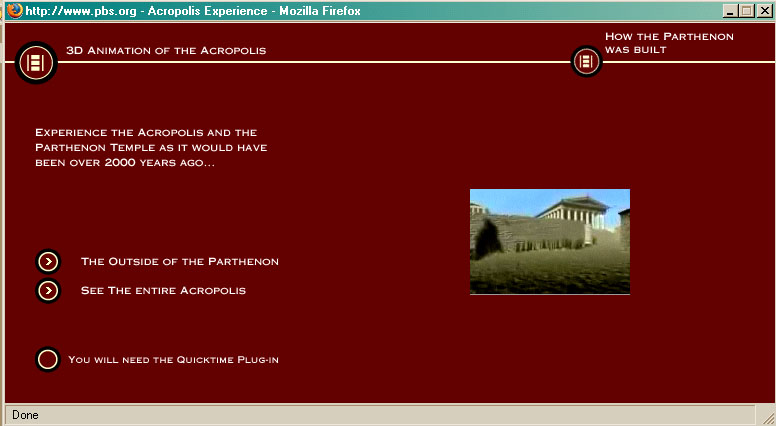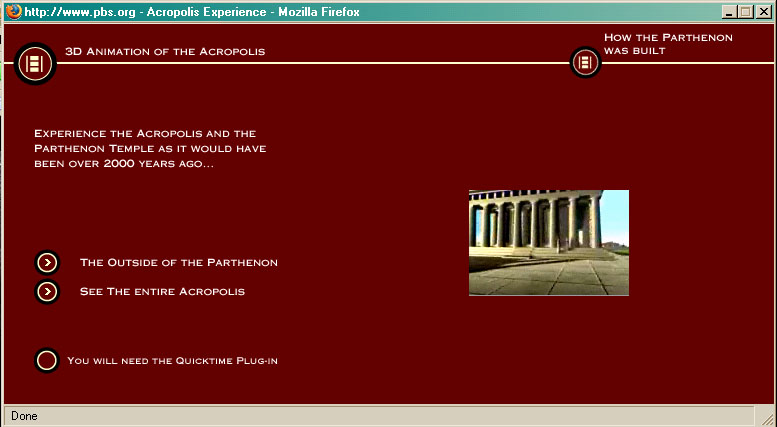
|
|
 |
Website Review: The Greeks: Crucible of Civilization
Susan C. JonesThis web site was constructed to accompany a televised documentary that appeared a number of years ago on American television. Along with features from the televised program, it contains a number of educational resources aimed at middle- and high-school students.
The title "The Greeks" is misleading -- this is a presentation of Athens and Athenian history, especially the period encompassing the period of Pericles' leadership and the Pelopennesian War. There is little mention of other city-states with the exception of Sparta and no discussion of the diversity of government forms that existed in ancient Greece other than the "democracy" of Athens and the "oligarchy" of Sparta. I will raise issues of intellectual content as I discuss the various sections of the site.
The opening page gives two avenues of access: Flash-4 and html. The content in the two sections is virtually the same, except that the html section does not include interactive features. Consequently, I only explored the Flash version which includes video clips, audio clips, and an interactive section. The site has the slick production values that I would expect from a cutting-edge commercial product of 2000. The animation is eye-catching without being too annoying. The color scheme is soothing and mostly readable while the navigation is relatively straight forward once you realize that you must click on buttons not the text. (The loud "kurchunk" as you pass the cursor over a button did begin to get on my nerves; turning off the sound is inconvenient because then the voice-over comments accompanying many of the pages are inaudible as well.)
The home page contains only a series of brief descriptions of the site's content and the choice of presentation formats. The site is divided into 4 main sections. Buttons providing linkage to those sections, a site index and the "Shop PBS" page remain in the left margin at all times. Explanatory text appears as the cursor crosses the navigation buttons.
No links go from the interior of one section to an interior point of another. Each internal link goes the top of the new section, and there is no search provided of the site. The site index is extensive but it is not a substitute for a general search that would show all pages that reference a topic. Of course, the reader may use an external search provided by her browser itself or a Google search on the domain if she is a sophisticated reader and is motivated.
There are the usual problems with broken, external hyperlinks, and links that no longer pertain to the subject. They are obvious and easily forgiven or overlooked in a 7-year-old site that seems to have had minimal maintenance.

Fig. 1 shows the opening position of the animated approach to the Parthenon.
The attractive, organized presentations of this site clearly show its origins as a collaboration of professional media producers. The producers have also assembled a great cast. The primary voice-over is performed by Liam Neeson, while pundits include Paul Cartledge, professor of ancient history at Cambridge and writer of the accompanying book; Josiah Ober, professor of ancient history at Princeton; and Nigel Spivey, lecturer in Classical art and archaeology at Cambridge. Their discussions have been edited to produce a smooth, orthodox version of Classical Athens as the birthplace and defender of democracy in the ancient Mediterranean world as well as the major center of art and learning for the Classical period. Nothing is allowed to detract from this viewpoint and the certainty that is implied by the deft presentation.
As stated in the opening paragraph, I have more problems with the intellectual contents of the site than with the features that are typically discussed in reviews of web sites -- the presentation, ease of navigation, etc.
Specifically, the animated clips may be visually stunning, but I doubt that contemporary Athenians could ever have seen the completed Panathenaic frieze (identified in the clip as the "Parthenon frieze that ran around the inner wall of the temple") at eye level! The clip presents contemporary Athenians viewing the frieze as if they are visitors filing past a poorly lit, modern museum exhibit. Only frieze sections showing the parade of Athenian citizenry are shown, and there is no attempt to show the frieze in its architectural context, either here or the external walk-through. The animated visit to the interior of the Parthenon is no more accurate; the interior is seen as dim with the looming figure of Athena dramatically appearing with stray beams of light falling on her face from above. Camera shots looking down from a position over her shoulder are equally stunning but again can not be a recreation of contemporary experience. None of these recreations credit the ancient sources or modern scholarship that provide their underpinnings.

Fig. 2 shows the end of the animated approach to the Parthenon.
The animations from "experiencing the Acropolis" are sterile without people and the numerous votive statues that must have existed. (I realize that to include this level of detail is not a trivial task. Decisions about what statues would have existed and where they would have been placed are daunting to comtemplate. Having to provide visual representations of them within a short animation is even more difficult.) In addition, the section should have been titled "experiencing the Parthenon" since that is the only visible building. The walk-through takes the visitor from a position just inside the Propylaea, around one side of the Parthenon, and up to the front entrance. It does not show the roof, details of the entablature or the pediments. The pull-back shot of the entire Acropolis starts from the same position inside the Propylaea, but is equally stark, showing only the positions of a few major buildings and the Athena Promachos on atop the Acropolis itself.

Fig. 3 shows the end of the animated pull-back showing a view of the entire Acropolis.
The list of ancient Greeks chosen to represent leading Athenians include 4 men (Cleisthenes, Pericles, Themistocles, and Socrates) and 1 woman (Aspasia). I have no problem with these choices, but the web page authors have again chosen to exclude alternative views about contemporary political conditions and to avoid mention of potential personal biases of these notables. Cleisthenes is presented as a "Great Man" and espouses his political genius in trusting the "ordinary" citizens to rule Athens. There is no mention of a major effect of his reforms -- to dilute the strength of his political enemies, a rather important consideration -- or of the number of Athenian inhabitants that were excluded from political participation. The other men are presented in a similar vein; Aspasia is presented as Pericles's paid companion. The voice-over suggests that she was unique in her intellect and influence in the male-dominated world of politics without stating the source for this opinion or the possibilities that other hetairai could have been in similar positions.
The Athenian bias of the video footage is less obvious in the educational resources, but it is still there. These lesson plans are aimed at middle- and high-school teachers who will incorporate the site into sessions on ancient history. The modern pedagogic, role-playing approach is admirable, full of activities calculated to enliven the teaching of ancient history and engage the students' mind in ways that a traditional history lesson of dates and wars will not. However, there are no critical discussions of the importance of sources and their biases. Although middle-school students can not be expected to operate on the same intellectual level as older students, they still can be exposed to different opinions and the process of critical thinking. Secondary-school students certainly deserve a more critical perspective. A simple example can be found in the first lesson, a table comparison of life under the democracy of Athens and the oligarchy of its rival Sparta. The Athenian political system is initially defined as a direct democracy, a system wherein "everyone, not just politicians, attended the assembly." Everyone is then defined as all citizens, ignoring restrictions on ostracized citizens (likely to be the most vocal of the current regime's opponents). Finally after describing elected officials, the Council of 500, and the jury system, comes the statement that women "did not participate in political life." The discussion of Sparta's political system is placed in an adjacent column. The discussion starts with the definition of oligarchy, and follows with a description of the assembly as attended by all male citizens over 30. The closing statement about Sparta is the same staement that "women did not participate in political life."
There is an interesting interactive section "Life in Athens" dealing with the opportunities available to Athenian and Spartan residents by gender and class which points up the limited possibilities for women and non-citizens. This is only place where such restrictions are openly stated, and they are not discussed in detail. Other role-playing sections place the student in the position of privileged male citizens; obviously the only one for which there are ancient textual sources.
The site is well-organized and shows the high production values that I would expect of a major undertaking by PBS and their supporters. It also provides the general public with effective imagery of major Athenian monument, but it falls short of engaging their critical faculties either for the accuracy of the recreations or view of history that is presented.
-- Susan C. Jones
For an index of other CD and Web site reviews available from the CSA Newsletter, see the review index.
For other Newsletter articles concerning the use of electronic media in the humanities, consult the Subject index.
Next Article: What Color Is That Pot?
Table of Contents for the Winter, 2007 issue of the CSA Newsletter (Vol. XIX, no. 3)
![]() Table of Contents for all CSA Newsletter issues on the Web
Table of Contents for all CSA Newsletter issues on the Web